Peonies: The Ultimate Guide To Planting and Growing Peonies
Lush, big, and beautiful, peonies have earned the reputation as the showiest spring flower! This guide on how to grow peonies explores planting and caring for this famous cut flower so you can enjoy its beauty in your own backyard.
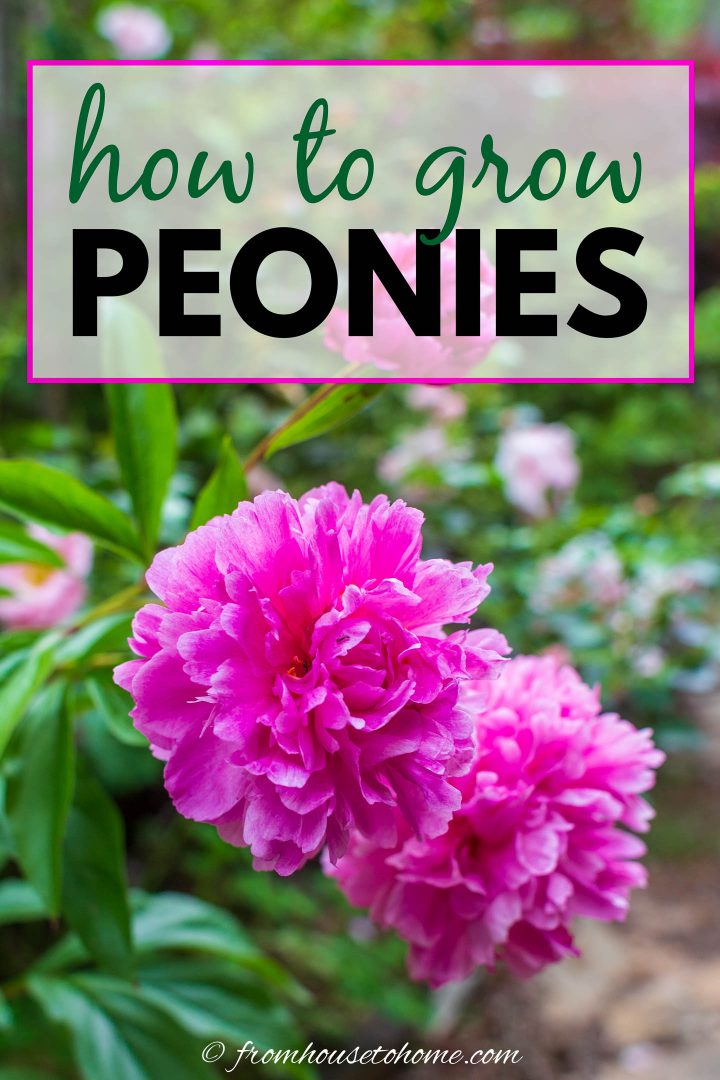
Marco Polo once famously called peonies, “roses as big as cabbages”.
I couldn’t agree more! The flowerheads burst through spring as though they have something to prove and stop people right in their tracks.
Add in that they’re low maintenance, the deer don’t like them and they often have a pretty scent, and it’s hard not to love them.
Here’s what we’re going to cover. (Click the links to go directly to a specific section)
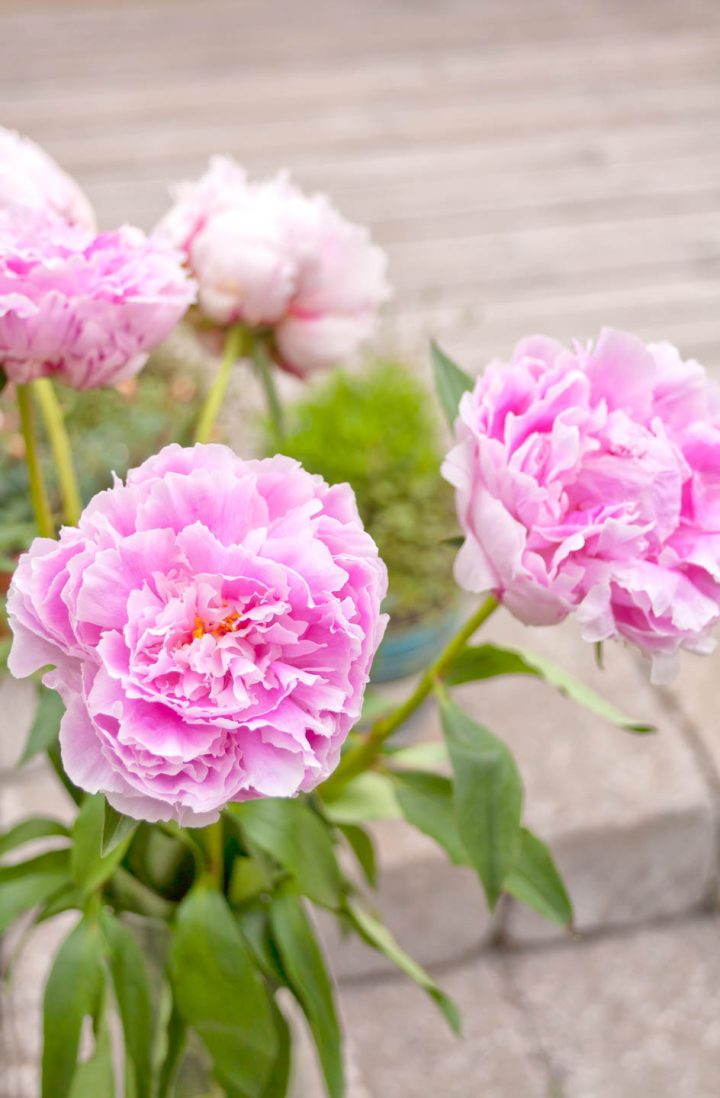
The basics
Zones: 2 to 8
Light: Full sun to part shade
Bloom Time: Spring
Height: 24″ to 36″
Spread: 24″ to 36″
Note: There are other types of peonies, such as Intersectional peonies and tree peonies, but here we’re focusing on the most popular type – the perennial herbaceous peony.
Where do they come from?
The herbaceous peony belongs to the genus Paeonia and the family Paeoniaceae.
There are over 33 species in the Paeonia genus, all native to Asia, Europe, and western North America.
Zones
Peonies can be grown in zones 2 to 8 (depending somewhat on the variety).
Because they need some chilling time in order to bloom, they can’t be grown in more southern zones where the winter weather is too warm.
Flower colors
Their big blooms come in pink, white, and red, with newer hybrids expanding color options to yellow, purple, mahogany, and more.
Flower forms
Peony flowers are available in many different forms.
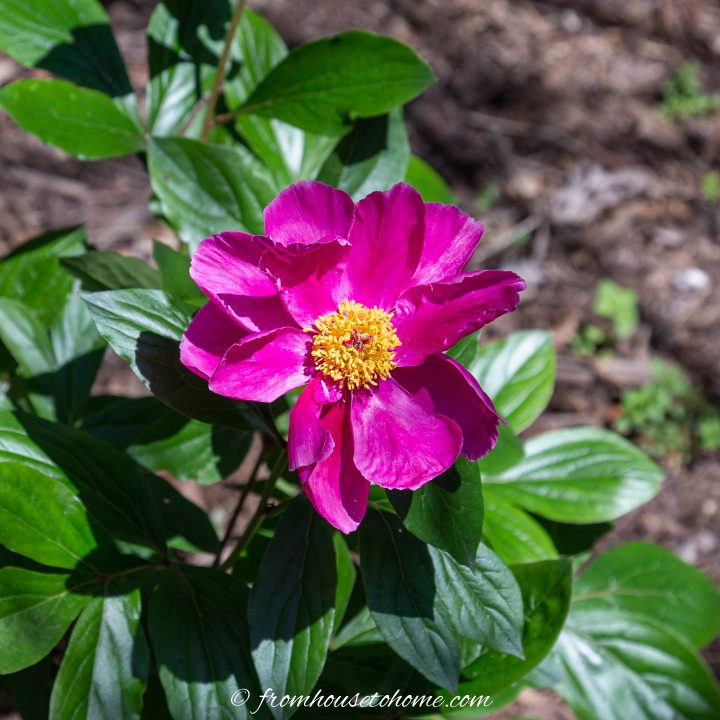
Some are singles with just one or two rows of petals around the stamens in the center.
I picked up this single peony at an end-of-season nursery sale, and it didn’t have a tag. So if anyone recognizes it, I would love to know what its name is.
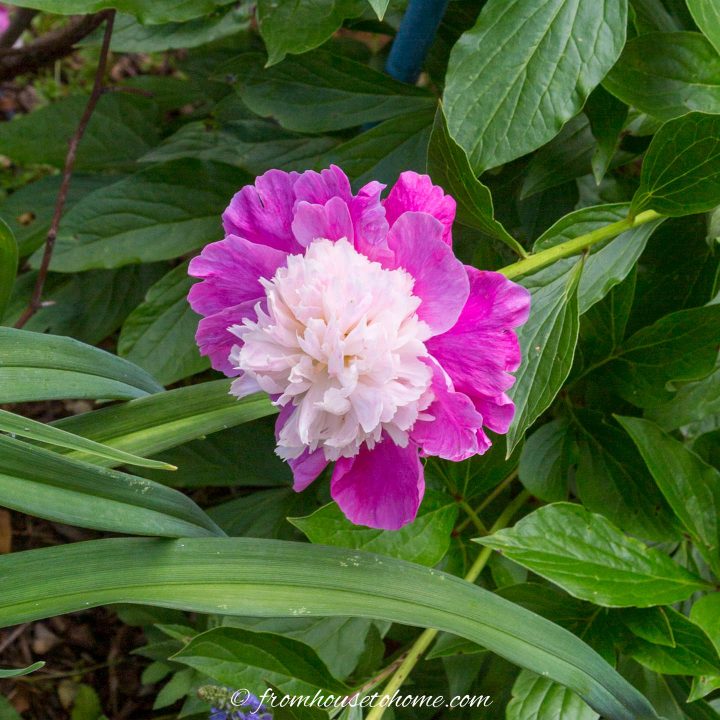
Some are semi-double, with three to five layers of outer petals (called guard petals) around a center of smaller ones.
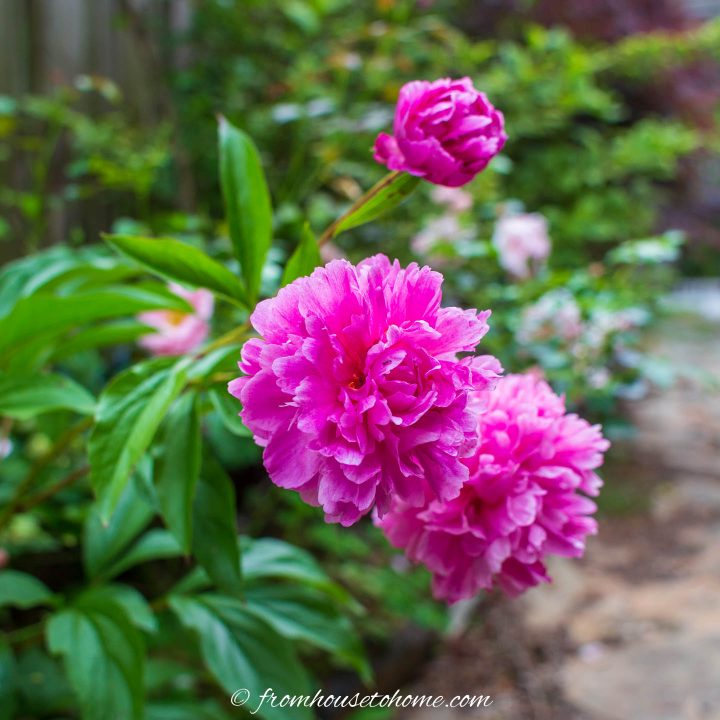
Still others are doubles, with full size petals all the way around, creating flowers that look like big, fluffy balls.
Bloom Time
Peonies bloom from the late spring to early summer, depending on the variety.
There are early, mid-season, and late blooming varieties available. So if you get a few different ones, you can have their pretty flowers in your garden for longer.
Once the pretty petals disappear for the year, the leaves will last all summer to keep your garden green.
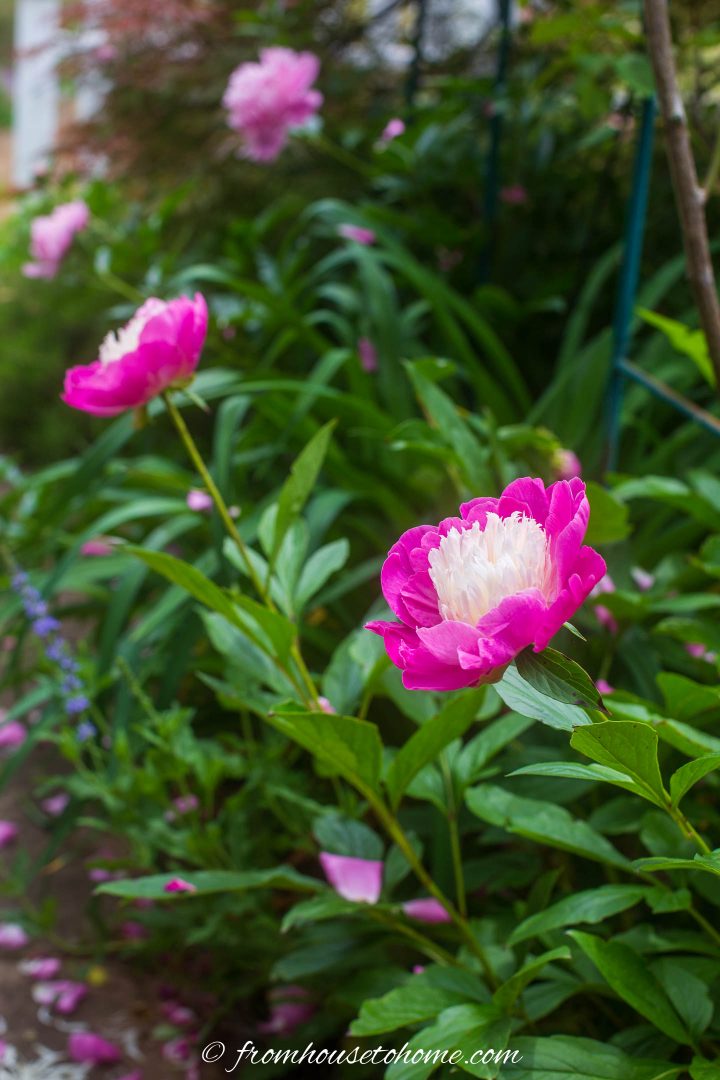
Size
Most peonies grow 24 to 36 inches tall and wide, with the flowers being a little taller.
They will get bigger every year as the tuberous root expands, but are definitely not aggressive.
And like most perennials, peonies die down to the ground in the winter, only to start over again in the spring.
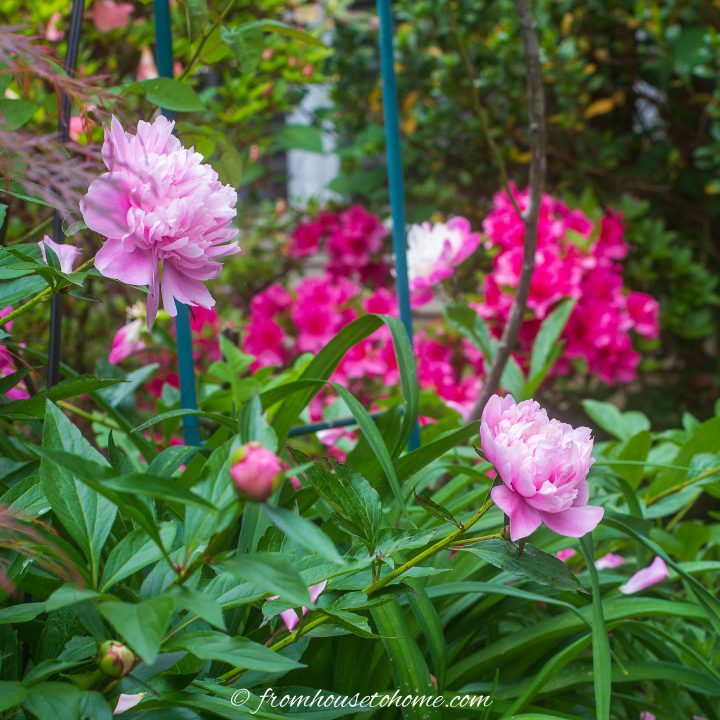
Other Interesting Facts
Most garden peonies will live more than 50 years. Plant one now and you’ll enjoy its beautiful flowers for many seasons to come.
They are also deer and rabbit resistant. Which is good news for your garden if you have these animals hanging around.
Many cultivars are quite fragrant. And the perfume can vary quite a bit from spicy to citrus-like to sweet depending on the variety.
Fun fact, peony flowers are edible! Sprinkle them on salads or drinks for a seasonal and fun garnish.
How to grow peonies
Pick the right location
Like choosing a house, knowing how to grow peonies is all about choosing the best spot.
This is especially important as they don’t like to be moved.
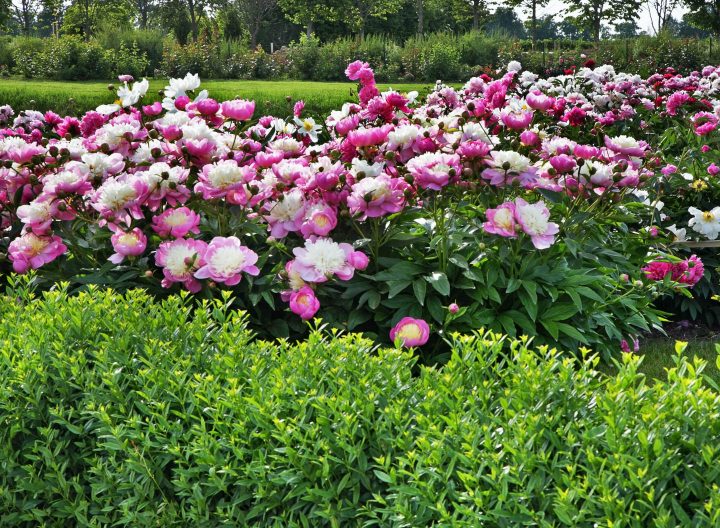
The herbaceous peony works wonderfully as a low hedge, along a walkway, or as a standalone shrub. Wherever you plant it, people are bound to be amazed by its spring blossoms.
If planting multiple peonies, plant them 3-4 feet apart so ensure they have enough room and air circulation upon reaching maturity.
Also, try not to plant them too close to other trees and shrubs as they don’t like to compete for nutrients and water.
Since peonies are top heavy, providing some shelter from wind is a good idea. Otherwise, they will be quick to topple over with a single strong gust.
Provide enough sun
In general, choose a place where your peony will receive full sun.
Peonies require 6 to 8 hours of sunlight a day in order to reach their full potential.
The exception to this rule is anyone who lives in warmer climates. In this case, you may want an area with partial shade in order to shield the flower from the heat of the mid-day sun.
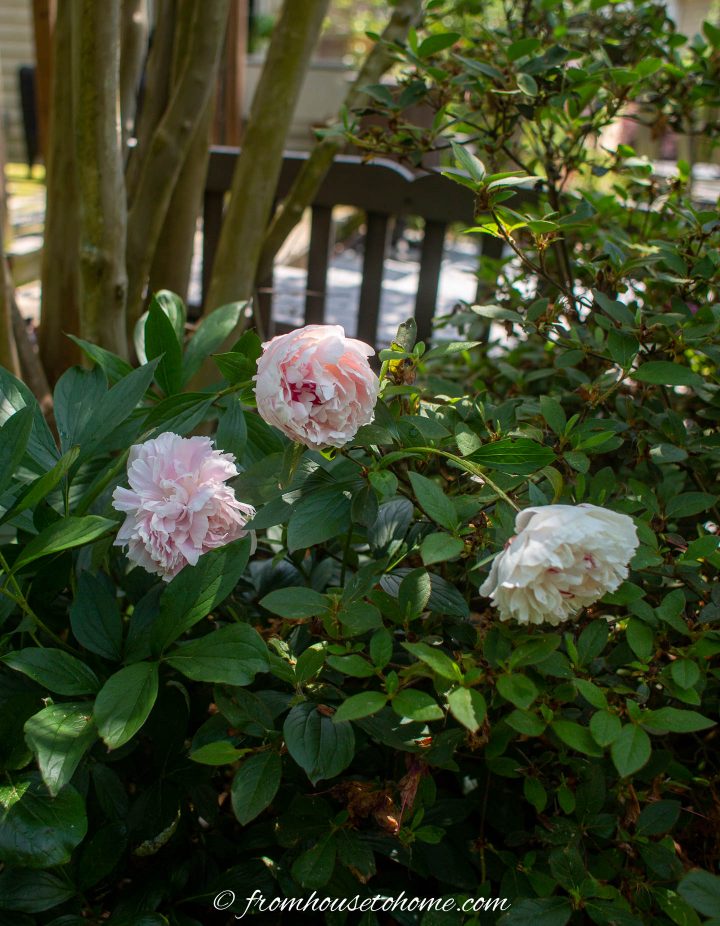
The peonies in this picture are growing in a pretty shady location right under a Crape Myrtle tree in my zone 7b garden and still bloom every year.
Check the soil
A happy peony prefers well-drained soil.
It should be able to hold moisture, but not be soaking wet. Poorly drained soil can result in root rot.
If you have a perfect spot but it has drainage issues, consider planting your peony in a raised bed.
Soil should also be rich and have a neutral to alkaline pH.
Taking a soil sample is a great way to determine if you need to add anything to the soil to make it more fertile or adjust the pH.
Clay soil will have to be heavily amended before a peony will do well growing in it.
How to plant bare root peonies

When you purchase a peony, it will often come as a bare root tuber from a plant that is 3-4 years old.
This looks like a hunk of root that will have eyes (buds at the base of the stem) growing from it.
Fall is the best season to plant bare root plants as it gives the roots more time to get established before they have to produce flowers. Make sure to get it in the ground at least 6 weeks before the ground freezes so it has some time to settle in.
You can also plant in the spring, but you probably won’t get any blooms the first year.
When planting, you want to dig a hole that is large enough for the root to fit in with a little room to spare.
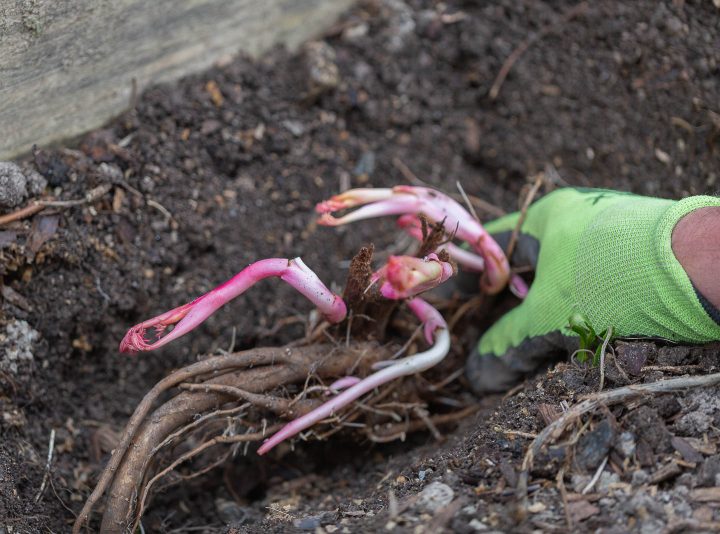
Plant them just below the soil surface (1 to 2 inches deep) with the eyes (buds) facing upward.
The planting depth is quite important for growing healthy peonies. Too deep, and your peony may not bloom as they require a cold period for buds to form. Too shallow and the tops of the eyes could freeze and die back.
Adding some compost to your soil will help provide the nutrients they need to get started.
How to plant container-grown peonies
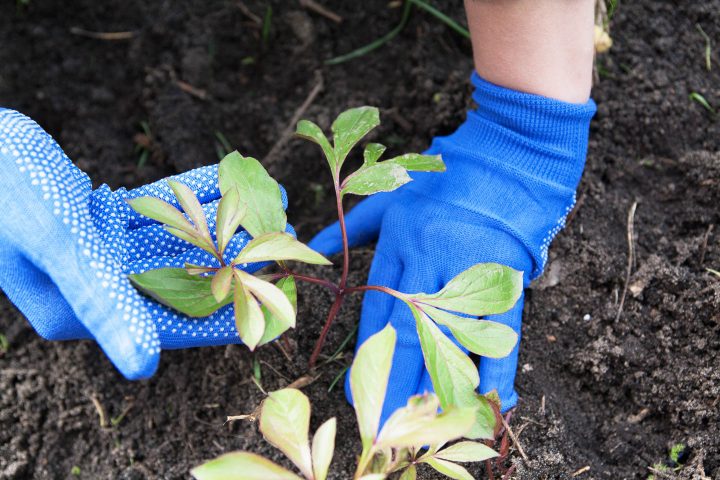
Alternatively, you can also find container grown peonies around garden centers in the spring.
These are easier to get going and if you buy them in bloom, you’ll know for sure what color they are.
Start by digging a hole that’s larger than the size of the pot.
Then make sure that the peony is planted no deeper than how it grew in the pot.
Fill in the rest of the hole with soil.
As with the bare root plants, adding some compost to your soil will help the peony get started.
How long do peonies take to grow?
Your peony may need a few years to establish itself before you begin to see the promised beautiful blooms, especially if you started with a peony root.
The first 3 years, you may get little to no flowers. Don’t panic, this is completely normal!
During the first few years, many professional growers will actually remove any flower bulbs to encourage the roots to develop.
Or, they let a single bloom remain so you can see what you have in store for you in the upcoming years.
By year 4, peonies really take off.
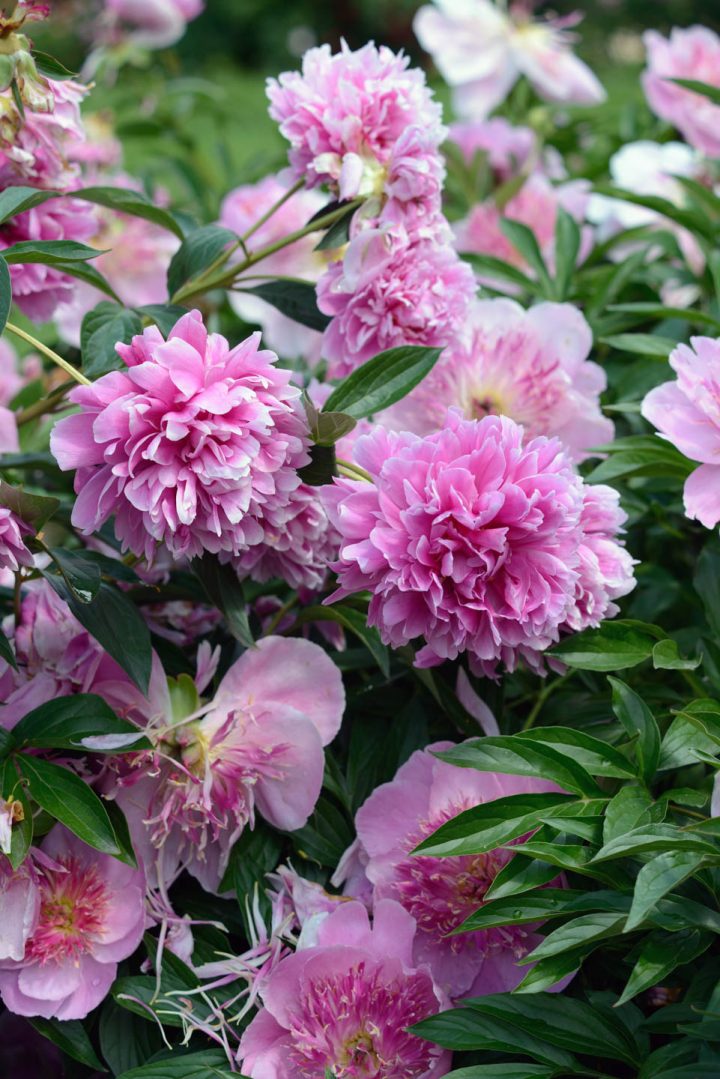
How to care for peonies
Once you’ve planted your flower, now it’s time to care for it! Learn how to grow peonies that thrive with these simple tips.
Water
While peonies don’t like sitting in wet soil, they still enjoy a good watering when they are new.
After being planted, they need to be thoroughly watered during their first year in order to get established.
However, after their first year you can stop with weekly watering as they are drought tolerant plants.
Overhead watering can weigh down the blooms, so soaker hoses work best.
After a heavy rainfall, you may want to shake the water off the flowers to prevent them from sagging.
Mulch
Applying a 3″ to 4″ layer of mulch around the base of your peony will help to keep the soil moist and the weeds down.
To prevent the plant from rotting, don’t cover the crown or have the mulch touching the stems.
Fertilizer
To tell you the truth, I don’t fertilize my peonies. They don’t really need it if they are planted in good soil.
Adding a layer of compost around the plant in the spring adds some extra nutrients to the soil.
However, if you do want to fertilize, apply a bulb or perennial fertilizer in the early spring. As with many other flowering plants, make sure it is lower in Nitrogen, otherwise you’ll end up with a lot of leaves and no flowers.
Regardless of whether you are using compost or fertilizer, distribute it around the crown but not on it to prevent damaging the plant.
Also, if you live in an area with acidic soil, sprinkling some lime around the base of the plant will help to keep your peony growing well.
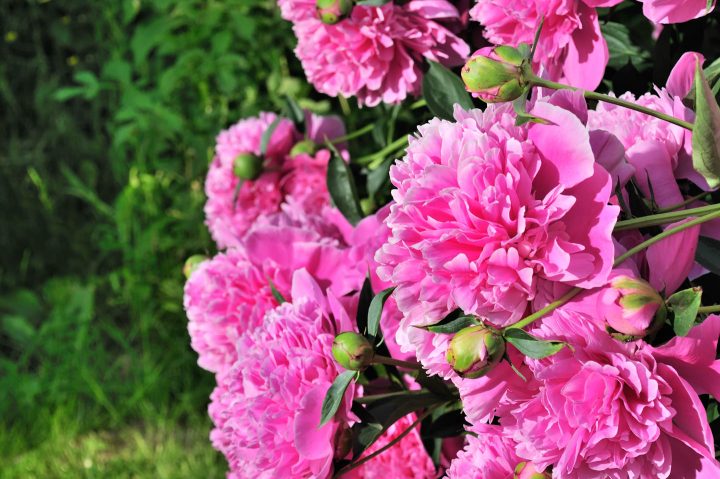
Support
Since they have such large and impressive blooms, peonies often need additional support. Without support, the stems will flop to the ground.
This is especially true if you live anywhere with lots of spring rain, as the weight of the water will also weigh down the plant.
To avoid floppy peonies, stake peonies individually once grown or start with a peony hoop or cage.
I recommend a cage as it is easier than having to stake each flower individually later.
Place the cage over the peony in early spring just as the leaves are starting to emerge. That way the plant will grow up through it as it gets bigger.
Pruning

Generally speaking, peonies don’t require pruning during the growing season.
If for some reason you do need to cut it back, prune right after the plant has finished blooming. Be careful to never remove more than 1/3 of the leaves since they provide the energy that allows the plant to grow stronger for the following year.
After your peony has finished blooming, you may want to deadhead the spent blooms. Remove the full flower head with a pair of sharp pruners, taking the stem all the way down to the next large leaf.
When summer has come and gone, and the peony leaves turn yellow and brown, it’s time to cut back your peony for the winter. Cut the foliage all the way to the ground. This will help to avoid foliar disease and reduce the chances of infection the following year.
Dividing
Peonies will very rarely need division and don’t like their roots to be disturbed since they take so long to get accustomed to their home.
If you must divide them, do so in the fall and cut each section so that they each have 2-5 eyes.
Always plant divisions immediately.
Disease and Pests
Overall, peonies are a hardy plant and you don’t have to worry too much about possible pests. Even the deer and rabbits don’t like them.
But there are a few fungal diseases to watch out for.
Peony leaf blotch
If your peony has black or brown patches on the leaves and stem, then it probably has the fungus known as Peony leaf blotch.
While not deadly to the plant, it does look unsightly.
To remedy, remove any of the infected leaves and stems immediately to avoid spreading the fungus.
To help prevent the fungus from surviving the winter on old leaves, a good fall clean up is important. Remove any fallen foliage and other plant debris around the peony. Then throw all of it into the garbage (not the compost pile) to avoid contaminating other parts of your garden.
See pictures and find out more HERE.
Powdery mildew
Powdery mildew is another common peony disease that causes the leaves to be covered with a white powdery coating.
Similar to leaf blotch, it doesn’t really harm the plant but it doesn’t help the look of your garden and can spread easily to other plants.
The primary cause for powdery mildew is not enough circulation and too much humidity.
Carefully spacing out peonies will help to avoid this issue.
As with many other fungi, removing all of the foliage and debris around the plant in the fall will help to prevent the problem from recurring.
See pictures and find out more HERE.
Botrytis blight (or Peony wilt)
Botrytis blight is another fungus that affects all areas of the plant. It causes the stems to turn brown or black and collapse. The buds may turn black and not open. And the leaves may be covered in a grey or black mold.
If you catch peony wilt early enough, you may be able to prevent it from spreading by cutting off the affected parts of the plant.
However, it can be difficult to eradicate, and removing the plant is often the best solution. Since it is a soil-born disease, don’t plant another peony in the same spot as it will likely end up with the same problem.
Again, a good fall cleanup of old leaves and other debris will help keep this disease out of your garden.
See pictures and find out more HERE.
What about the ants?
You may also notice how much ants love peonies.
Fear not, ants are completely harmless to your peony plant.
They like to eat the peony nectar as a source of carbohydrates so they can often be found walking around on the peony buds.
While annoying, ants can actually help the plants by attacking other flower bud eating pests.
But they’re usually gone by the time the blooms open, so they’re only a temporary annoyance.
How to cut peonies for a bouquet
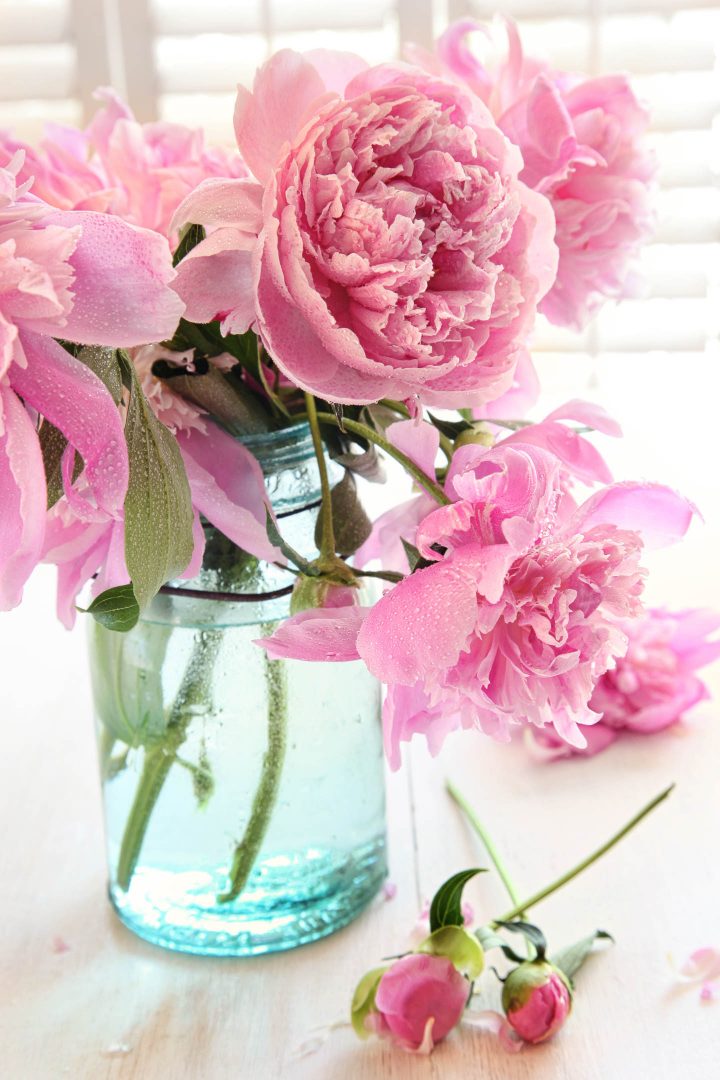
Such a lush and bold flower, it comes as no surprise that peonies are a favorite for floral designers to include in their bouquets. You too can bring the cut flowers inside as peonies from the garden also do well in a vase.
How to cut flowers
Carefully selecting peonies will help ensure they last for as long as possible indoors.
You want the peony to still be in a tight bud. When you squeeze, it should feel like a squishy marshmallow. Most of the bud will still be green, with about ½ inch of colorful petals visible.
Cut your peonies in the morning before the heat of the day sets in.
Ensure you give yourself more than enough stem length for your vase and then cut the stem at an angle above a leaf.
After cutting, carefully dunk the peony heads in a bucket of cool water and swish around to remove any ants. There shouldn’t be very many at this stage, but you still don’t want to bring them in the house!
Shake off the water and bring the peonies inside.
At this point, you can place them in a vase and the buds will open 24-48 hours later, lasting around 7-10 days.
How to store flowers for later use
Apparently, you can also store peonies and use them up to 3 months later!
I haven’t tried this, but according to the Michigan State University Extension, you should wrap the peonies completely in plastic wrap making sure to seal the ends.
Then place them in the fridge.
When you’re ready to use them, give the stems a fresh cut and place in lukewarm water to help wake them up.
If you love peonies as much as I do, you might want to read about tree peonies HERE. They can grow in the shade!
Other Gardening Ideas You Might Like
- How to Grow Lilacs: Spring’s Most Fragrant Flower
- 25+ of the Best Plants that Attract Hummingbirds
- 10 Tips for Creating Flower Combinations that Work
Have comments or questions on how to grow peonies? Leave me a comment in the section below.
This post was originally published on April 1, 2021 but was updated with new content on November 23, 2024.























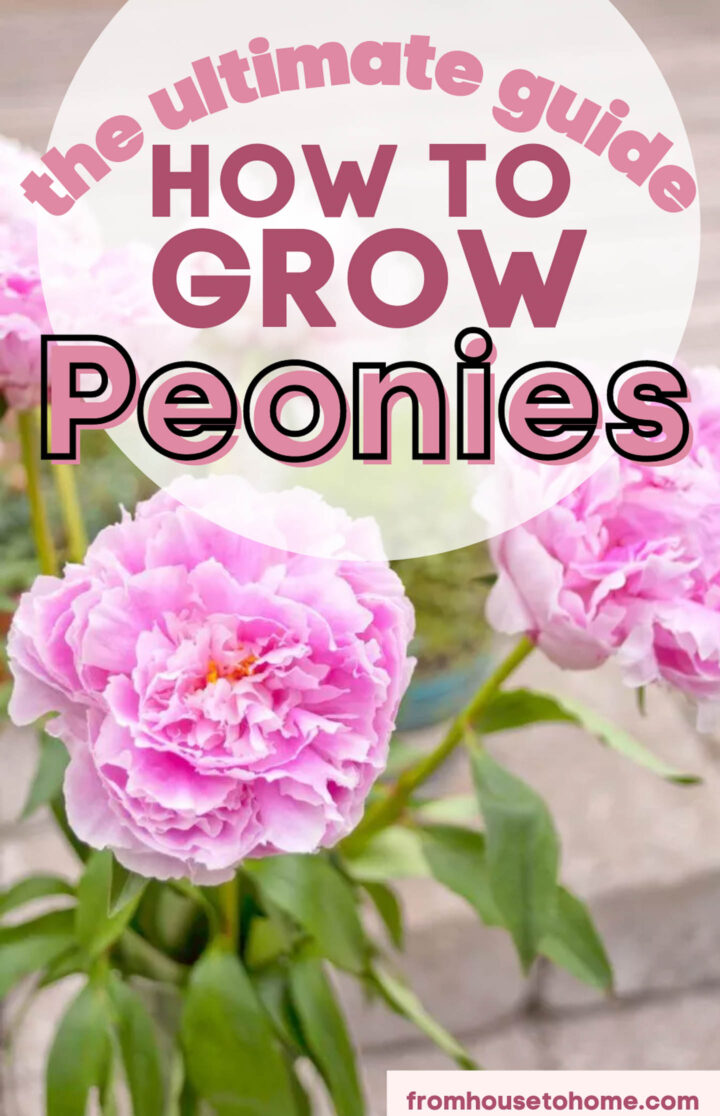
All the facts I needed to know THANKS!!
Thanks, Joan! I’m happy it was helpful 🙂
Hi Wanda, I think the unnamed peony you asked about is “Comanche”. I also love peonies, and most of mine get early morning sun and afternoon shade and bloom fine. Living in hot humid Virginia, I think some shade is a good thing. I sometimes pinch off the side buds, leaving just one on the stem, which allows for a considerable larger single bloom. I grow all mine now in raised beds or heavily amended soil, as heavy clay is such a challenge to try and growth most anything in. Happy summer to you.
Thanks for the peony name and the growing suggestions, Charisse. Happy gardening!